Genome-Wide Identification and Evolution Analysis of R2R3-MYB Gene Family Reveals S6 Subfamily R2R3-MYB Transcription Factors Involved in Anthocyanin Biosynthesis in Carrot
- PMID: 36233158
- PMCID: PMC9569430
- DOI: 10.3390/ijms231911859
Genome-Wide Identification and Evolution Analysis of R2R3-MYB Gene Family Reveals S6 Subfamily R2R3-MYB Transcription Factors Involved in Anthocyanin Biosynthesis in Carrot
Abstract
The taproot of purple carrot accumulated rich anthocyanin, but non-purple carrot did not. MYB transcription factors (TFs) condition anthocyanin biosynthesis in many plants. Currently, genome-wide identification and evolution analysis of R2R3-MYB gene family and their roles involved in conditioning anthocyanin biosynthesis in carrot is still limited. In this study, a total of 146 carrot R2R3-MYB TFs were identified based on the carrot transcriptome and genome database and were classified into 19 subfamilies on the basis of R2R3-MYB domain. These R2R3-MYB genes were unevenly distributed among nine chromosomes, and Ka/Ks analysis suggested that they evolved under a purified selection. The anthocyanin-related S6 subfamily, which contains 7 MYB TFs, was isolated from R2R3-MYB TFs. The anthocyanin content of rhizodermis, cortex, and secondary phloem in 'Black nebula' cultivar reached the highest among the 3 solid purple carrot cultivars at 110 days after sowing, which was approximately 4.20- and 3.72-fold higher than that in the 'Deep purple' and 'Ziwei' cultivars, respectively. The expression level of 7 MYB genes in purple carrot was higher than that in non-purple carrot. Among them, DcMYB113 (DCAR_008994) was specifically expressed in rhizodermis, cortex, and secondary phloem tissues of 'Purple haze' cultivar, with the highest expression level of 10,223.77 compared with the control 'DPP' cultivar at 70 days after sowing. DcMYB7 (DCAR_010745) was detected in purple root tissue of 'DPP' cultivar and its expression level in rhizodermis, cortex, and secondary phloem was 3.23-fold higher than that of secondary xylem at 110 days after sowing. Our results should be useful for determining the precise role of S6 subfamily R2R3-MYB TFs participating in anthocyanin biosynthesis in carrot.
Keywords: R2R3-MYB family; anthocyanin; carrot; evolution; expression profile; transcription factor.
Conflict of interest statement
The authors declare no conflict of interest.
Figures









References
-
- Arscott S.A., Tanumihardjo S.A. Carrots of many colors provide basic nutrition and bioavailable phytochemicals acting as a functional food. Compr. Rev. Food Sci. Food Saf. 2010;9:223–239. doi: 10.1111/j.1541-4337.2009.00103.x. - DOI
-
- Kammerer D., Carle R., Schieber A. Detection of peonidin and pelargonidin glycosides in black carrots (Daucus carota ssp. sativus var. atrorubens Alef.) by high-performance liquid chromatography/electrospray ionization mass spectrometry. Rapid Commun. Mass Spectrom. 2010;17:2407–2412. doi: 10.1002/rcm.1212. - DOI - PubMed
-
- Xu Z.S., Huang Y., Wang F., Song X., Wang G.L., Xiong A.S. Transcript profiling of structural genes involved in cyanidin-based anthocyanin biosynthesis between purple and non-purple carrot (Daucus carota L.) cultivars reveals distinct patterns. BMC Plant Biol. 2014;14:262. doi: 10.1186/s12870-014-0262-y. - DOI - PMC - PubMed
MeSH terms
Substances
Grants and funding
LinkOut - more resources
Full Text Sources

